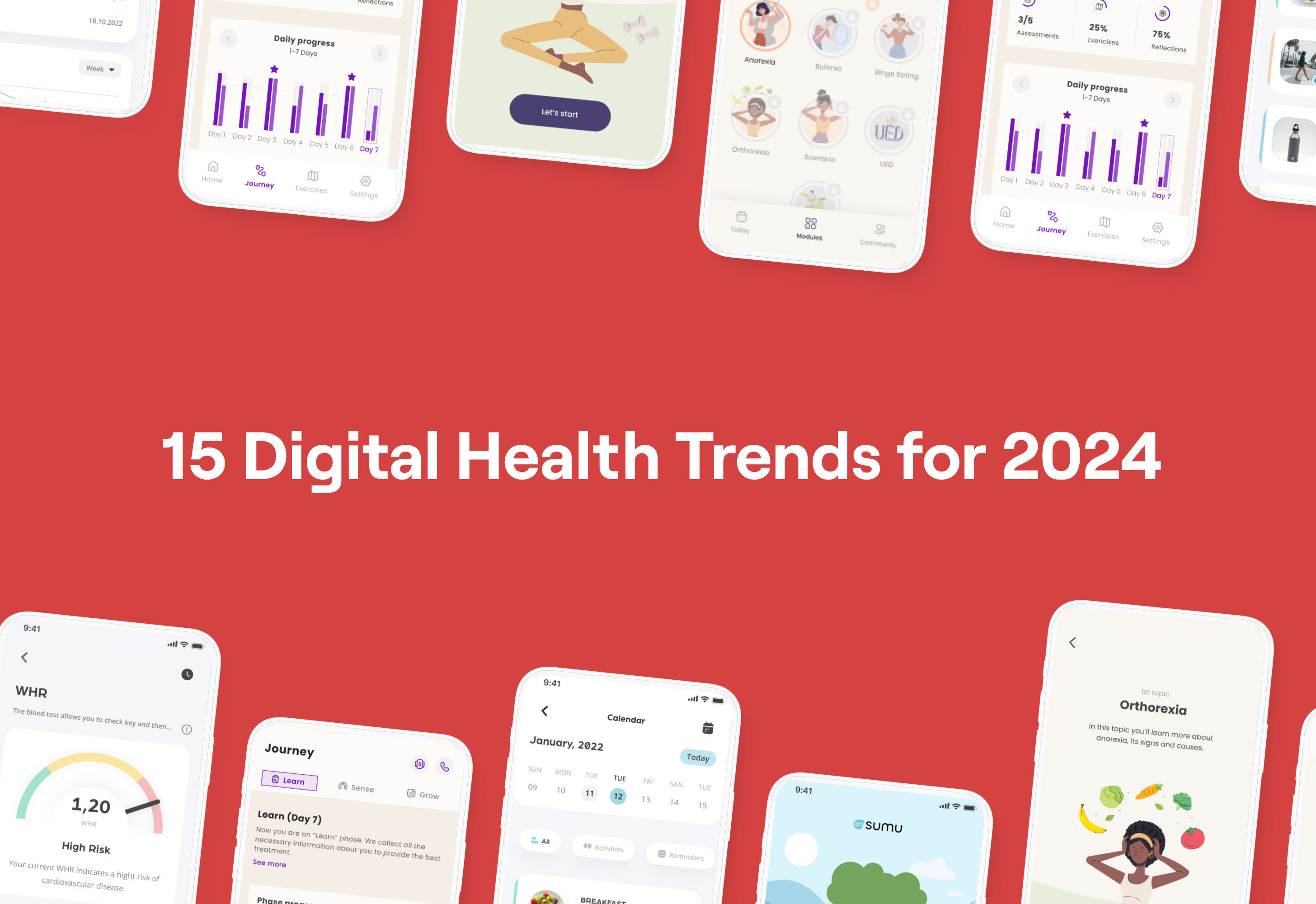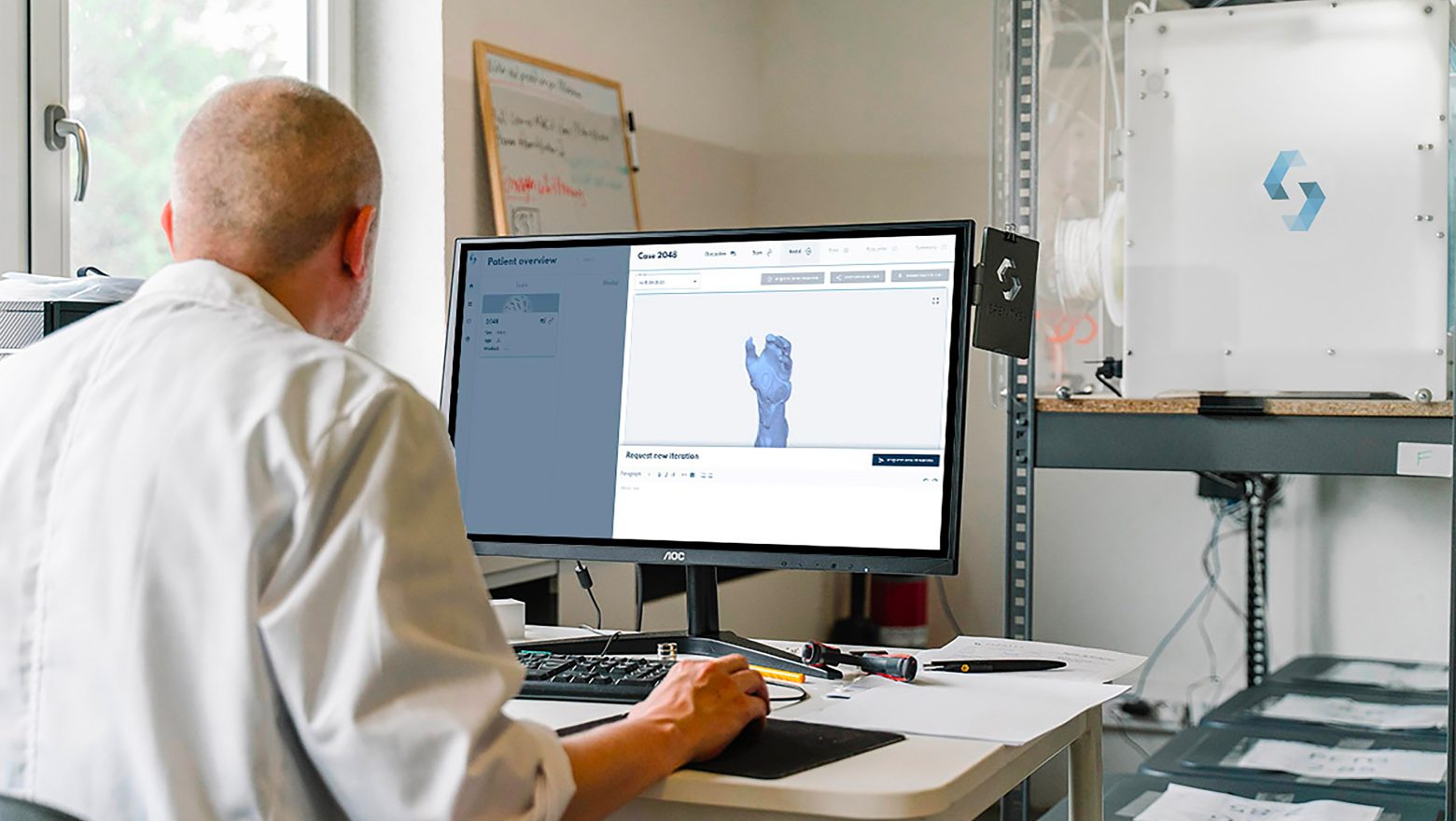One of the motivations behind establishing Nozomi was our desire to simplify things for people. We sought to make it easier for individuals to access treatment, manage chronic conditions, and monitor their current well-being.
We recognize that addressing even the slightest challenges demands effort from individuals. Hence, we consistently embrace innovations within the healthcare industry that aim to streamline the treatment journey for diverse individuals.
Today, Dr. Julian, founder of Dr Julian Medical Group & NHS Clinical Entrepreneur, and we will showcase the digital health trends that have caught our attention in 2024.
By the way, before we dive into our article, for keeping track of emerging technology trends in healthcare industry, you can explore our selection of 100 resources (books, guides, websites, and influencers) about Product Management, UX, Technology, Healthcare market trends, and Product Marketing.
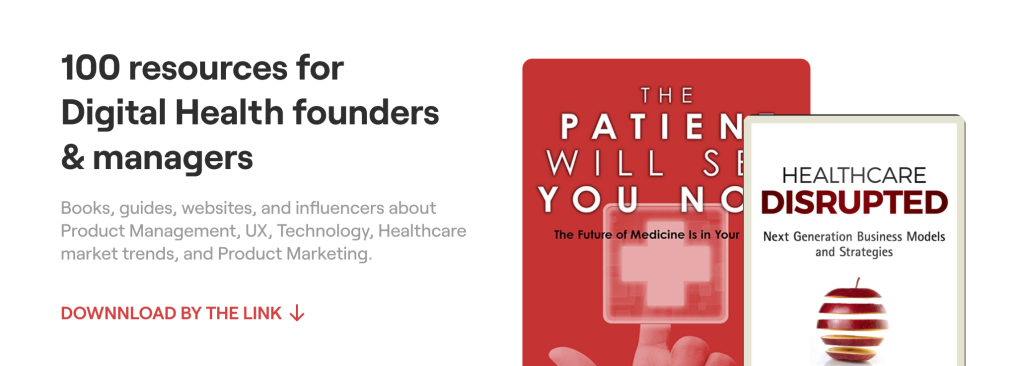
Download List of 100 resources for digital health startup founders & managers
1. Emergence and ethical considerations of AI in healthcare
The first from healthcare trends 2024. And first of all, we need to emphasize that safety is the primary consideration, as LLMs have not yet been proven to be safe in a healthcare setting, particularly in terms of the advice they could provide.
Today machine learning algorithms, powered by vast datasets, are at the forefront of enhancing diagnostics, crafting personalized treatment plans, and fundamentally improving patient outcomes. This trend spans various domains, from the interpretation of medical imaging to the discovery of novel drugs, predictive analytics, and the facilitation of telemedicine.
As AI systems continue to mature, healthcare professionals are empowered to make more informed decisions, streamline workflows, and deliver efficient and effective care to patients. The emergence of AI in healthcare is unlocking the potential for a proactive and personalized approach to medicine, heralding a new era in the industry.

Source: Microshift
Ethical considerations at the forefront: however, with great innovation comes the responsibility to navigate complex ethical considerations associated with the integration of AI in healthcare. The following ethical dimensions are pivotal in shaping the responsible use of AI:
Privacy and security: the utilization of AI involves the handling of sensitive patient data. Balancing the benefits of improved healthcare outcomes with the imperative of safeguarding patient privacy is a critical ethical challenge.
Transparency and accountability: the inherent ‘black box’ nature of some AI algorithms demands a focus on understanding their decision-making processes. Establishing transparency and accountability in AI-driven decisions, particularly in critical healthcare scenarios, becomes imperative.
Equity in access: the deployment of AI should not exacerbate existing healthcare disparities. Efforts must be concerted to ensure that AI technologies are accessible to all segments of the population, preventing the creation of healthcare inequalities.
Informed consent: patients must be adequately informed about how AI will be employed in their healthcare. Respecting the principle of informed consent is essential for maintaining trust and respecting individual autonomy.
Bias mitigation: AI systems, if not carefully developed, may perpetuate biases present in historical healthcare data. Ethical AI implementation necessitates rigorous efforts to identify and mitigate biases, ensuring fair and equitable treatment for all patient populations.
As stakeholders collaborate to establish robust frameworks, the responsible and ethical integration of AI into healthcare will pave the way for unprecedented advancements. Addressing these ethical considerations is paramount in maximizing the positive impact of AI on the trajectory of healthcare in 2024 and new health innovations.
2. Enhanced Strategies for Data Breach Mitigation
The healthcare sector is an attractive target for cybercriminals due to the treasure trove of valuable personal and medical data it holds. What protection methods will be trending?
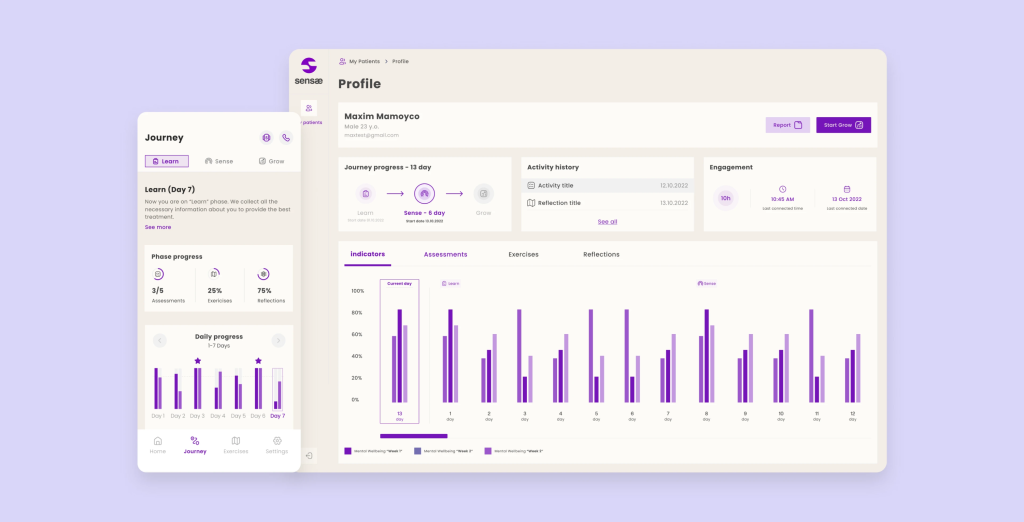
Source: Sensae
Key strategies for data breach mitigation in 2024:
Advanced encryption protocols: implementing state-of-the-art encryption protocols is a foundational strategy to protect patient data. By encrypting data both in transit and at rest, healthcare entities can thwart unauthorized access even if security perimeters are breached.
Multi-factor authentication (MFA): enhancing access controls through MFA adds an additional layer of security by requiring users to verify their identity through multiple means. This significantly reduces the risk of unauthorized access, especially in cases of compromised credentials.
Continuous monitoring and threat detection: proactive monitoring of network activities and the use of advanced threat detection tools are instrumental in identifying anomalies and potential security breaches in real-time. Early detection allows for swift response and containment.
Employee training and awareness: human error remains a leading cause of data breaches. Comprehensive training programs to educate healthcare staff about cybersecurity best practices, phishing awareness, and the importance of adhering to security protocols are crucial for preventing inadvertent breaches.
Zero trust architecture: adopting a Zero Trust approach involves treating every user and device as potentially untrusted, regardless of their location within the network. This model ensures that access permissions are dynamically adjusted based on continuous verification of identity and device security posture.
Incident response planning: having a well-defined incident response plan is indispensable for minimizing the impact of a data breach. Rapid response, containment, and communication protocols are integral components of an effective response strategy.
3. Expansion of the internet of medical things (IoMT)
The Internet of Medical Things (IoMT) stands out as a revolutionary in healthcare and technology trends, set to continue its upward trajectory in 2024 with an anticipated growth surpassing 110 billion, a notable increase from the 90.69 billion recorded in 2023.
This technology plays a pivotal role in assisting healthcare facilities in consolidating various components, including hospital management systems, patient and hospital mobile apps, Electronic Health Records (EHR) and Electronic Medical Records (EMR) platforms, wearables, and other interconnected technologies.

Source: Sero
It establishes a unified network that facilitates proper storage and structuring of health data, continuous monitoring, real-time analysis of updates, and seamless sharing of Protected Health Information (PHI) across different entities within this network.
Specifically, IoMT contributes significantly to the management of patient health information within medical facilities, mitigating the risks of data loss, confusion, unauthorized access, and reducing the likelihood of human errors in health records.
The integration of wearables and mobile apps has become integral to medical practice in recent years. Wearable medical devices and remote patient monitoring have become indispensable tools in hospitals.
An impressive 86% of adults in the US perceive wearables as effective instruments for achieving their wellness and fitness goals. Devices such as smartwatches, bracelets, rings, and others equipped with integrated biosensors play a crucial role in the round-the-clock monitoring of patient health conditions, including blood pressure, heart rate, blood oxygen levels, and other vital signs.
These medical wearables establish connectivity to a medical facility’s patient information management system, enabling the tracking of disease progression and immediate alerts for emergent cases. They prove particularly beneficial for patients with chronic diseases that necessitate daily monitoring and updates. They are new healthcare technologies.
4. Consolidation of Big Data with healthcare operations
The integration of Big Data with healthcare operations is emerging technologies in healthcare industry, marking a strategic convergence of data analytics within the healthcare landscape.
In the ever-evolving healthcare sector, the consolidation of Big Data with healthcare operations is positioned as a transformative force. This trend emphasizes the amalgamation of vast datasets, encompassing patient records, diagnostic information, treatment outcomes, and operational statistics, to derive meaningful insights and optimize healthcare processes.
Several prevalent origins of extensive data within the healthcare domain encompass electronic health records (EHRs), individual health records (IHRs), and electronic medical records (EMRs). Additionally, it encompasses data produced by wearable gadgets and mobile applications dedicated to health.
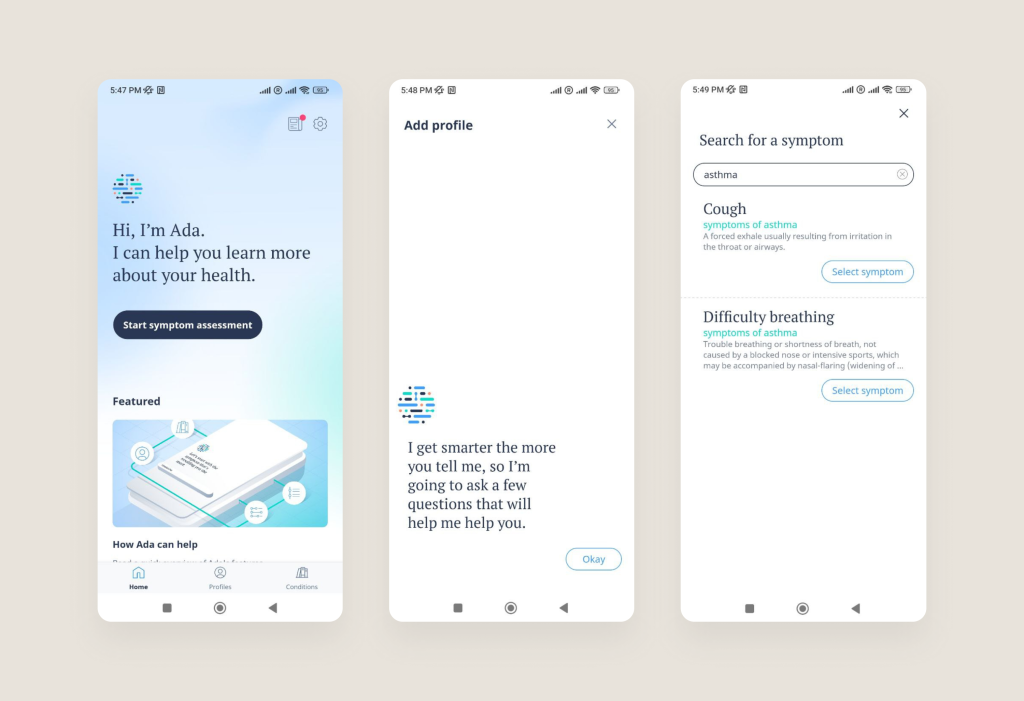
Source: Ada
5. Stronger collaboration between insurers and care providers
Collaboration between insurance providers and healthcare entities is poised to become even more robust in the coming years, marking one from significant digital trends in healthcare.
This collaborative approach aims to create a seamless connection between insurers and care providers, fostering better communication, streamlined processes, and improved patient outcomes. The synergy between these two critical components of the healthcare system is expected to enhance the overall efficiency, reduce administrative complexities, and contribute to a more patient-centric approach.
Insurers and care providers are increasingly recognizing the benefits of working closely together. This collaboration involves sharing relevant health data, optimizing reimbursement processes, and implementing joint strategies for preventive care and chronic disease management.
The potential to create innovative insurance models that are tailored to the specific needs of patients and healthcare providers. By aligning financial incentives and healthcare goals, insurers and care providers can jointly contribute to the advancement of value-based care.
The collaboration also addresses challenges related to billing, claims processing, and administrative overhead. Streamlining these aspects can result in a more efficient allocation of resources, reducing costs for both insurers and care providers.
Moreover, a stronger collaboration can lead to the development of data-driven insights that benefit both parties. By leveraging analytics and shared data, insurers can gain a deeper understanding of patient populations, enabling them to design more effective insurance products. Care providers, on the other hand, can utilize this data to enhance care delivery, personalize treatments, and improve overall patient satisfaction.
6. Widespread adoption of telehealth services
We think you saw this among digital health trends of recent years. But here we speak about development.

Source: Allbry
Telemedicine plays a pivotal role in addressing numerous challenges encountered by healthcare facilities in both patient care and internal process management. Notably, the demand for telehealth is witnessing significant growth in the USA and Europe, driven by the encouragement and support of digital health solutions by governments. This surge can be attributed to the increasing global prevalence of chronic diseases and the need for effective solutions that enable early disease detection and effective management.
The primary objective behind the adoption of telehealth solutions is to furnish patients with high-quality healthcare services, ensuring their satisfaction and facilitating easier access to medical assistance. Healthcare institutions leverage virtual health systems to effectively manage patients, even in a partially remote manner. This approach aids in maintaining control over patient data and its security, as well as overseeing staff, treatment procedures, and medication plans.
To delve deeper into the practical application of telehealth solutions, our involvement in developing an MVP enclosure and firmware for the TCC electronic nurse device is a noteworthy example. This medical solution empowers patients to measure and manage their health vitals while receiving a personalized therapy plan based on their health data.
While telemedicine apps have evolved into reliable tools for delivering quality care and managing patients remotely, it is crucial to highlight that these telehealth systems must adhere to various legal and healthcare requirements. In the subsequent discussion, we will explore these compliance aspects in detail.
7. Immersive technologies in patient care
This is the real example of new advances in healthcare technology. Augmented and virtual reality technologies have been integrated into the healthcare sector, revolutionizing the approach to physician training and patient treatment.
Virtual reality offers aspiring healthcare professionals a practical learning experience, enabling them to enhance their skills through simulated surgeries and physical therapy scenarios, providing a valuable complement to traditional theoretical learning methods.
Furthermore, virtual reality proves invaluable for rehearsing complex surgeries, mitigating potential health risks by allowing practitioners to simulate and refine their techniques in a controlled virtual environment before entering real-life scenarios.
On the other hand, augmented reality has significantly advanced the analysis and diagnosis of patients’ CT scans or 3D medical images. By precisely detecting the root causes of diseases, augmented reality contributes to more accurate and informed medical decision-making.
8. Digital health innovators going public
The next of healthcare trends 2024 is to be public. It reflects a significant shift in the healthcare industry, signaling a maturation and increasing recognition of the value of digital health solutions. Several innovative companies in the digital health space have chosen to go public, leveraging initial public offerings (IPOs) to raise capital and enhance their market presence.
This trend is indicative of the growing demand and acceptance of digital health technologies, both by investors and the broader public. Going public provides digital health innovators with the financial resources needed to scale their operations, invest in research and development, and expand their offerings. It also allows them to reach a wider audience of potential users and customers.
Investors are increasingly recognizing the transformative potential of digital health solutions in improving patient outcomes, enhancing healthcare delivery, and addressing existing challenges within the healthcare system. As a result, digital health companies that go public gain access to the necessary funding to further innovate, refine their products, and navigate the complex regulatory landscape.
The move towards public offerings in the digital health sector not only signifies the industry’s growth but also highlights the commitment of these companies to long-term sustainability and impact. This trend is likely to continue as digital health continues to play a pivotal role in shaping the future of technology in healthcare, fostering innovation, and improving overall health outcomes.
9. The rise of healthcare consumerism
The rise of healthcare consumerism represents a fundamental shift for medical technology trends, empowering individuals to take a more active role in managing their health and making informed decisions about their care. This trend is characterized by a shift from a passive patient role to an empowered consumer mindset, driven by increased access to health information, technological advancements, and changing expectations.
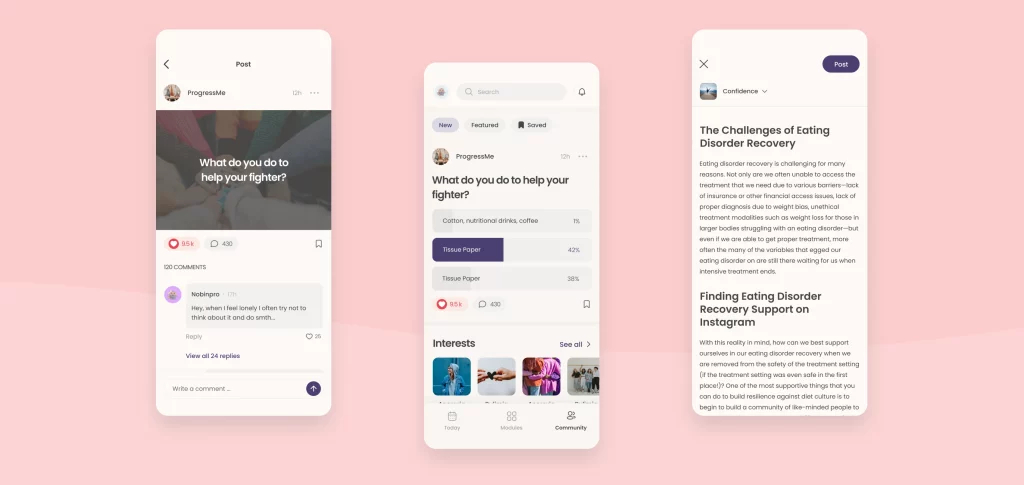
Source: ProgressMe
Key Aspects of Healthcare Consumerism:
Access to information: with the proliferation of digital health resources, individuals now have unprecedented access to health information. Online platforms, medical apps, and wearable devices provide consumers with data about their health, enabling them to make more informed choices and actively participate in healthcare decisions.
Personalization of care: healthcare consumerism emphasizes personalized and patient-centric care. Consumers are seeking tailored healthcare experiences that align with their preferences, values, and individual health needs. This includes personalized treatment plans, digital health tools, and remote monitoring options.
Telehealth and virtual care: the adoption of telehealth and virtual care services has accelerated, providing consumers with convenient and accessible healthcare options. Telemedicine allows individuals to consult with healthcare professionals remotely, eliminating geographical barriers and enhancing the overall patient experience.
Healthcare technology integration and new health innovations: wearables, health apps, and other digital tools are integral to healthcare consumerism. These technologies enable individuals to monitor their health metrics, track fitness levels, manage chronic conditions, and actively engage with their well-being. Integration with electronic health records (EHRs) further enhances coordination of care.
Price transparency: healthcare consumerism advocates for increased transparency in healthcare pricing. Consumers are seeking clarity on the cost of medical services, procedures, and prescription medications. Price transparency initiatives aim to empower individuals to make cost-conscious decisions about their healthcare.
Patient advocacy and engagement: empowered consumers are becoming advocates for their health. They actively engage with healthcare providers, participate in shared decision-making, and seek out providers who prioritize communication and collaboration. Patient engagement is seen as a critical factor in improving health outcomes.
Wellness and preventive care: healthcare consumerism places a strong emphasis on wellness and preventive care. Individuals are proactively adopting healthier lifestyles, leveraging preventive services, and exploring wellness programs to maintain optimal health and prevent the onset of chronic conditions.
10. Tailored treatments via precision medicine
New healthcare technologies? Sure! Precision medicine represents a recent technological advancement in healthcare, introducing a personalized approach to patient care. This innovative approach goes beyond traditional laboratory tests, including blood tests, CT scans, X-rays, and genetic testing.
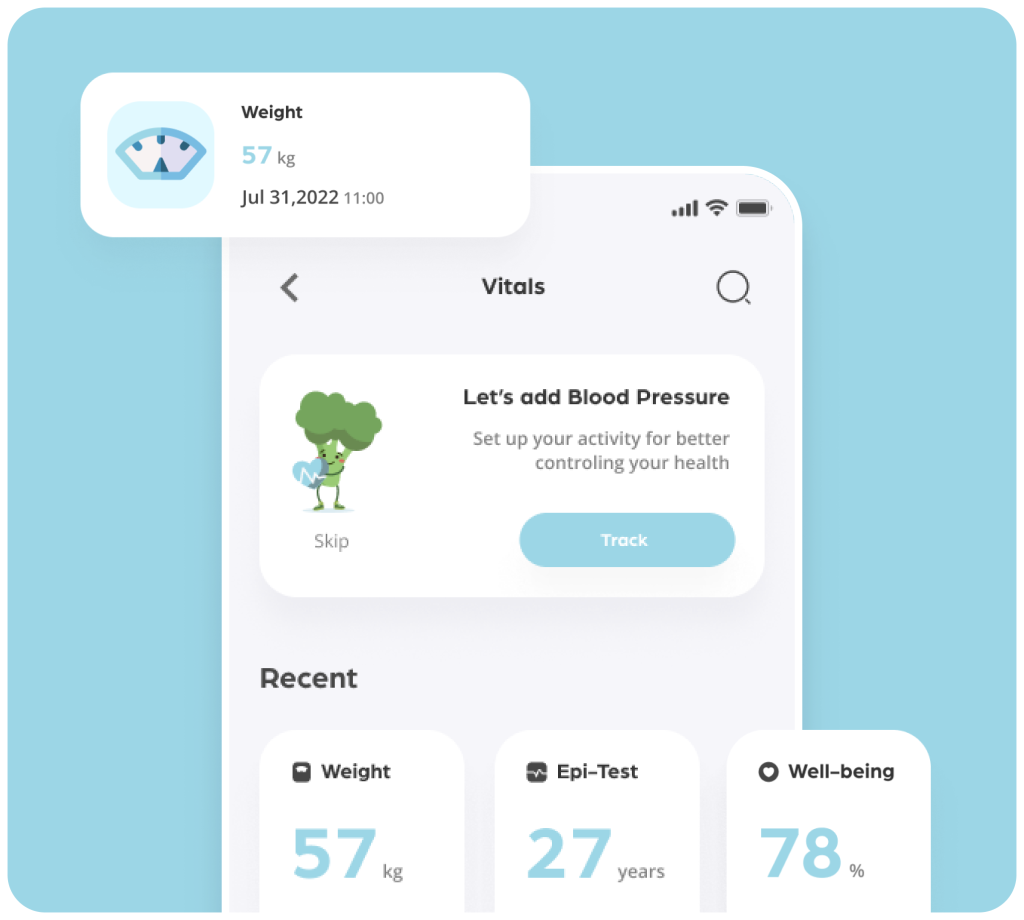
Source: Sumu
Precision medicine takes into account various factors such as the patient’s lifestyle, living environment, genetic makeup, and individual characteristics to tailor a treatment plan that is both effective and suitable.
The field of precision medicine primarily encompasses two key areas: targeted drug therapy designed to eradicate cancer cells and immunotherapy, which harnesses the immune system to combat cancer. Through in-depth analysis of patients’ genetic profiles and specific characteristics, healthcare providers can offer treatments that are not only efficient but also reduce the time required to overcome the disease.
This personalized approach marks a significant shift in medical care, acknowledging the unique aspects of each patient for more effective and targeted interventions.
11. Comprehensive Clinical Decision Support Systems (CDSS)
Clinical Decision Support Systems (CDSS) seamlessly merge patient and clinical data, providing healthcare professionals with valuable insights directly at the point of care.
This integrated system plays a pivotal role in disease diagnosis, recommending suitable treatment options, and notifying physicians of potential issues, including drug interactions or allergies. By enhancing the decision-making process, CDSS contributes to improved decision quality, reduced errors, and the promotion of evidence-based practice in healthcare settings.
12. Advanced Laboratory Information Management Systems (LIMS)
Also between medical technology trends we can see Laboratory Information Management Systems (LIMS). They are instrumental in overseeing laboratory workflows, encompassing tasks such as sample tracking, test ordering, and results reporting. These systems play a crucial role in enhancing the precision and efficiency of laboratory processes, ensuring the seamless management of diagnostic information in a timely manner.
13. Implementation of digital twin technology in healthcare
Source: Siemens Healthineers
What about healthcare IT future trends? Imagine having a virtual replica of a medical device or even the human body that can be thoroughly tested and analyzed in a virtual environment. What if there was a technology that could potentially reverse a person’s health condition or, even better, prevent diseases altogether? Well, digital twin technology offers a solution to these intriguing questions.
Digital twin technology enables the creation of virtual replicas of medical devices, biological materials, and even the human body. The benefits for medical professionals are substantial, allowing them to conduct comprehensive testing and analysis without the need for physical models. The impact is truly remarkable for new advances in healthcare technology.
One of the groundbreaking applications of digital twin technology is in enabling remote surgeries. By utilizing a virtual twin, surgeons can practice and simulate surgeries in advance, arriving at the hospital with a clear understanding of the procedure, ultimately enhancing the precision and success of the operation.
Additionally, this technology empowers doctors to predict the effectiveness of medicines and identify optimal remedies for patients. The implementation of digital twin technology opens up new possibilities in the realm of healthcare, transforming the way medical professionals approach diagnosis, treatment, and surgery.
14. Human-centric design in healthcare software
This is the future of technology in healthcare. We have written quite a bit about this trend in a full article. Read it here.
And if you want to delve a bit deeper into this topic, we’ve also created a comprehensive guide on how to boost CX and user engagement:
1. Our best CX (UI/UX) practices to make an app not just used but loved
2. Product strategies to drive retention and engagement
3. Our best Engineering practices to build scalable solutions
4. Tips to ensure compliance with healthcare regulations
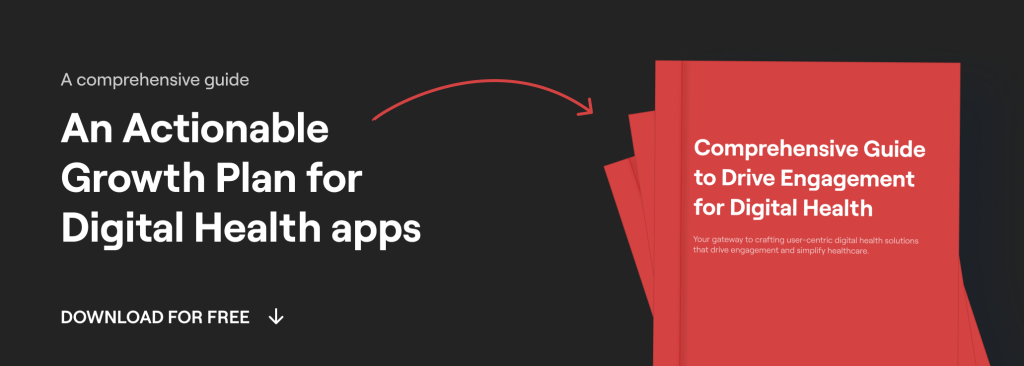
Download Free Actionable Insights to Grow your Digital Health app
15. Expansion of mobile health (mHealth) applications
As technology continues to advance, the expansion of mHealth applications contributes to the democratization of healthcare, empowering individuals to take proactive measures towards their health goals.
The seamless integration of mobile technologies into healthcare represents a transformative shift, enhancing accessibility, patient engagement, and overall health outcomes. This is one from technology trends in the healthcare industry that underscores the ongoing evolution of healthcare delivery in the digital age, fostering a more connected and participatory approach to personal health management.
Conclusion
The evolving landscape of healthcare trends 2024 mirrors the dynamic changes in the healthcare sector driven by technological advancements. The integration of Artificial Intelligence, telehealth, IoMT, and precision medicine is reshaping patient care and operational efficiency.
These trends underscore the industry’s commitment to innovative, accessible healthcare solutions, compliance management. Software developers face the challenge of navigating these trends while catering to the evolving needs of the healthcare landscape.
The healthcare sector is witnessing a transformative phase in software innovation, promising to enhance patient outcomes and streamline workflows. This evolution contributes to the development of a connected, responsive, and interlinked healthcare ecosystem.
By the way, here we wrote about Product Healthcare Trends of 2024
And we hope this article was useful for you!

Who we are? We are a digital health product studio, who transforms healthcare digital experiences and sets new standards for delivering digital healthcare in a way that positively impacts people’s lives.
We assist healthcare startups in designing and developing digital products, while also helping healthcare organizations undergo transformative changes.
If you are interested about our experience check our portfolio with case studies by the link or you can read more about us here.
And write to us now on m@nozomihealth.com and we will discuss how we can help ensure that your product brings real benefits.


